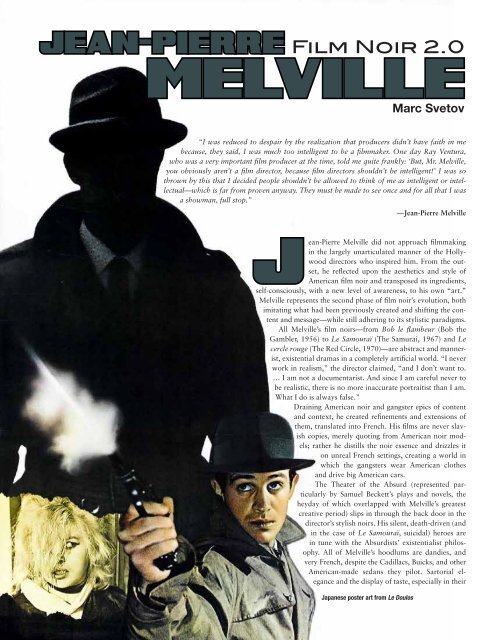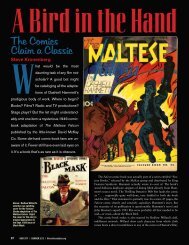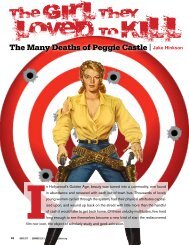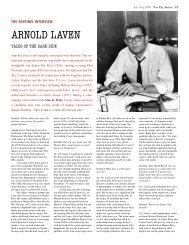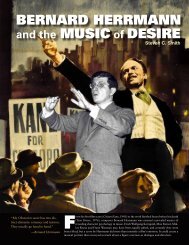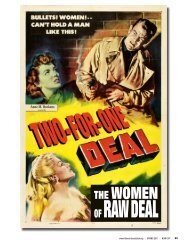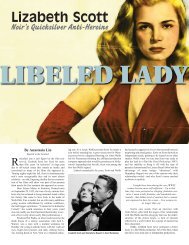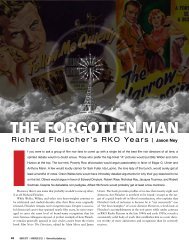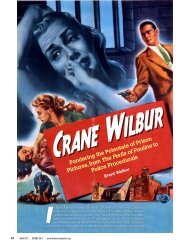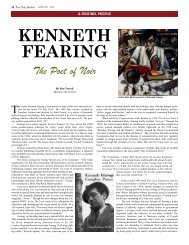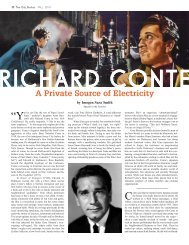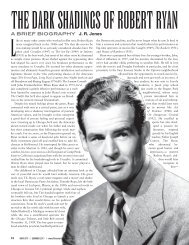Jean-Pierre Melville - Film Noir 2.0 - Transatlantic Habit
Jean-Pierre Melville - Film Noir 2.0 - Transatlantic Habit
Jean-Pierre Melville - Film Noir 2.0 - Transatlantic Habit
You also want an ePaper? Increase the reach of your titles
YUMPU automatically turns print PDFs into web optimized ePapers that Google loves.
JEAN-PIERRE<br />
38 noir citY i Summer 2011 i www.filmnoirfoundation.org<br />
<strong>Film</strong> <strong>Noir</strong> <strong>2.0</strong><br />
MELVILLE<br />
Marc Svetov<br />
“I was reduced to despair by the realization that producers didn’t have faith in me<br />
because, they said, I was much too intelligent to be a filmmaker. One day Ray Ventura,<br />
who was a very important film producer at the time, told me quite frankly: ‘But, Mr. <strong>Melville</strong>,<br />
you obviously aren’t a film director, because film directors shouldn’t be intelligent!’ I was so<br />
thrown by this that I decided people shouldn’t be allowed to think of me as intelligent or intellectual—which<br />
is far from proven anyway. They must be made to see once and for all that I was<br />
a showman, full stop.”<br />
—<strong>Jean</strong>-<strong>Pierre</strong> <strong>Melville</strong><br />
<strong>Jean</strong>-<strong>Pierre</strong> <strong>Melville</strong> did not approach filmmaking<br />
in the largely unarticulated manner of the Hollywood<br />
directors who inspired him. From the outset,<br />
he reflected upon the aesthetics and style of<br />
American film noir and transposed its ingredients,<br />
self-consciously, with a new level of awareness, to his own “art.”<br />
<strong>Melville</strong> represents the second phase of film noir’s evolution, both<br />
imitating what had been previously created and shifting the content<br />
and message—while still adhering to its stylistic paradigms.<br />
All <strong>Melville</strong>’s film noirs—from Bob le flambeur (Bob the<br />
Gambler, 1956) to Le Samouraï (The Samurai, 1967) and Le<br />
cercle rouge (The Red Circle, 1970)—are abstract and mannerist,<br />
existential dramas in a completely artificial world. “I never<br />
work in realism,” the director claimed, “and I don’t want to.<br />
… I am not a documentarist. And since I am careful never to<br />
be realistic, there is no more inaccurate portraitist than I am.<br />
What I do is always false.”<br />
Draining American noir and gangster epics of content<br />
and context, he created refinements and extensions of<br />
them, translated into French. His films are never slavish<br />
copies, merely quoting from American noir models;<br />
rather he distills the noir essence and drizzles it<br />
on unreal French settings, creating a world in<br />
which the gangsters wear American clothes<br />
and drive big American cars.<br />
The Theater of the Absurd (represented particularly<br />
by Samuel Beckett’s plays and novels, the<br />
heyday of which overlapped with <strong>Melville</strong>’s greatest<br />
creative period) slips in through the back door in the<br />
director’s stylish noirs. His silent, death-driven (and<br />
in the case of Le Samouraï, suicidal) heroes are<br />
in tune with the Absurdists’ existentialist philosophy.<br />
All of <strong>Melville</strong>’s hoodlums are dandies, and<br />
very French, despite the Cadillacs, Buicks, and other<br />
American-made sedans they pilot. Sartorial elegance<br />
and the display of taste, especially in their<br />
Japanese poster art from Le Doulos
<strong>Melville</strong> on location<br />
apartments (Le Doulos, Le cercle rouge), are their<br />
hallmarks, as though to say: It is all about style,<br />
this crime career. American movie gangsters of the<br />
1930s, ’40s, and ’50s of course wore fancy clothes<br />
and finery, maintaining their wardrobe as strictly as<br />
if they were soldiers in uniform. <strong>Melville</strong>’s French<br />
counterparts follow this pattern, but Alain Delon<br />
is significantly more narcissistic than Paul Muni or<br />
George Raft (Scarface, 1932) could ever be.<br />
A good example of the unique American-French<br />
palimpsest <strong>Melville</strong> enjoyed fabricating can be<br />
found in L’Ainé des Ferchaux (1963); he took pride<br />
in having shot portions of the film in France, while<br />
tricking viewers into believing the entire movie had<br />
been made in America. In 1971, he was asked about<br />
shooting certain scenes:<br />
Q. Where did you shoot that scene in the bank?<br />
A: In a bank.<br />
Q. Yes …. but what I meant was, in France or in<br />
America?<br />
A: In America. Why? You look as though you didn’t<br />
believe me.<br />
Q. Not at all.<br />
A: Well, you shouldn’t. As a matter of fact, I shot<br />
that scene at the Société de Générale in the Boulevard<br />
Hausmann because all banks look alike. … I<br />
was therefore obliged to shoot certain exteriors in<br />
France: the sequence with the hitchhiker, the scene<br />
at the river and so on. …<br />
Q. What is there of America in the film then?<br />
A: Only things that are typically American…. Obviously,<br />
I didn’t film “the streets of New York” in the<br />
rue Jenner, but all the scenes on the highway were<br />
shot in France. If you look carefully, however, you<br />
will see that none of the cars are French, because<br />
I’d lined the Esterel autoroute with American cars.<br />
“Strangely, <strong>Melville</strong>’s films about<br />
the underworld created their own<br />
mythical milieu. But the myth wasn’t<br />
French, it was inspired by the mythology<br />
of American film noir. He<br />
was steeped in America, it influenced<br />
him profoundly.”<br />
—Bernard Stora, assistant<br />
director on Le cercle rouge<br />
“<strong>Melville</strong> was a great American filmmaker,<br />
lost in France.”<br />
—Rui Nogueira<br />
<strong>Melville</strong>’s noir cycle<br />
<strong>Jean</strong>-<strong>Pierre</strong> <strong>Melville</strong>’s film noir<br />
career begins in the mid-1950s with<br />
Bob le flambeur. “A real hood’s<br />
face,” says Bob, looking at himself in<br />
a mirror on the street. Bob is played<br />
www.filmnoirfoundation.org i Summer 2011 i noir citY 39
Roger Duchesne (center) as gambler “Bob” Montagné<br />
by Roger Duchesne, a minor French film star from the 1930s. <strong>Melville</strong><br />
chose him specifically because the actor was “over the hill.”<br />
Set in Paris (Montmartre, Pigalle) and a gambling casino in Deauville,<br />
the film shows us Bob’s last coup, a heist professionally planned<br />
and carried out—but, unfortunately for Bob and his criminal companions,<br />
it is foiled at the final moment by Inspector Ledru (Guy<br />
<strong>Pierre</strong> Grasset and <strong>Jean</strong>-<strong>Pierre</strong> <strong>Melville</strong> on location in New York for Deux hommes dans Manhattan<br />
40 noir citY i Summer 2011 i www.filmnoirfoundation.org<br />
Decomble), who, wanting to protect Bob, has warned him repeatedly<br />
not to do anything that would put him in jail. At Bob’s age, he won’t<br />
survive another stretch of hard time.<br />
The film offers an ironic twist, as Bob makes a huge score at the casino’s<br />
roulette table before the robbery even takes place: he doesn’t even<br />
need to commit the robbery, but still sets it in motion. Inspector Ledru,<br />
however, catches everybody in the act. Bob’s young protégé Paulo (Daniel<br />
Cauchy) is shot and killed as Bob emerges from the casino, his winnings<br />
in hand. Ledru arrests him and the others, allowing Bob to stash<br />
his spoils in the trunk of the police car. As they ride together to the police<br />
station, Bob jokes with Inspector Ledru that, thanks to his luck at the<br />
tables, he can afford a good lawyer. He suggests that he’ll get off with a<br />
light sentence—and maybe even sue for damages.<br />
Deux hommes dans Manhattan (Two Men in Manhattan, 1959)<br />
features the director himself in the role of French journalist Moreau,<br />
working for the French press agency in New York, who investigates<br />
the mysterious disappearance of a UN delegate, Fèvre-Berthier.<br />
Moreau enlists the help of disreputable tabloid photographer Delmas<br />
(<strong>Pierre</strong> Grasset), a cynic as well as a drunk. They find the diplomat<br />
dead from a heart attack in his American mistress’ apartment.<br />
Delmas rearranges the death scene for maximum sensationalism and<br />
takes several lurid shots to sell to the newspapers.<br />
Moreau’s boss, explaining to them the man’s previous career as a<br />
Resistance fighter, convinces Delmas to surrender the roll of scandal-
ous pictures. Instead, Delmas turns over a roll that has nothing to do<br />
with the incident. Realizing what his duplicitous colleague has done,<br />
Moreau chases down Delmas and confronts him. Eventually, Delmas<br />
tosses the film in the gutter, throwing away the big break that would<br />
have made his career. He exits laughing.<br />
Le Doulos (Doulos: The Finger Man, 1962), with Serge Reggiani<br />
and <strong>Jean</strong>-Paul Belmondo in the main roles, is a complexly plotted<br />
noir involving the apparent betrayal by the police informer Silien<br />
(Belmondo) of his friend, the burglar Faugel (Reggiani). Doulos is<br />
French slang for a hat, as well as an informer. For most of the film,<br />
one believes that Silien is betraying Faugel, selling him out to the police;<br />
he even kills Faugel’s girlfriend, Therèse (Monique Hennessy).<br />
From his jail cell, Faugel vows revenge on Silien, contracting with<br />
his cellmate, Kern (Charles Studer), to kill his traitorous friend. In<br />
the end, it is revealed that Silien has been protecting Faugel all along,<br />
trying to clear him of a murder charge. In a spectacular climactic<br />
shoot-out at Silien’s home, both protagonists die in a hail of bullets.<br />
Silien’s doulos rolls off his head on to the floor, and the film ends.<br />
<strong>Melville</strong> released L’Ainé des Ferchaux (The Oldest Son of Ferchaux)<br />
in 1963, casting in the main roles Belmondo and the aging<br />
Charles Vanel (of Wages of Fear fame). <strong>Film</strong>ing in color, <strong>Melville</strong><br />
shot extensive exteriors in America. L’Ainé des Ferchaux is a perverse<br />
tale of a banker, Ferchaux (Vanel), who must flee France due<br />
to a financial scandal and some vague crimes in his past—the murder<br />
of “three Negroes” in Africa. As he is preparing to escape to<br />
America, Ferchaux hires ex-boxer Maudet (Belmondo) as his traveling<br />
secretary. Driving from New York to Caracas, Maudet picks up<br />
an American hitchhiker and has sex with her. Ferchaux is jealous,<br />
<strong>Jean</strong>-Paul Belmondo and Charles Vanel in L’Aimé des Ferchaux<br />
and the psychological warfare between the two men escalates from<br />
there. In Louisiana, they are trailed by FBI agents, who tell Maudet<br />
that although neither Frenchman will be allowed to leave the U.S.,<br />
Ferchaux will not be extradited. Maudet keeps this crucial bit of<br />
information to himself.<br />
Maudet plays sadistic psychological power games with the older<br />
man; Ferchaux submits to Maudet, pouts like a jilted lover (the homosexuality<br />
is implied but not explicit), and the rapidly aging Ferchaux<br />
soon grows ill. Maudet abandons him, taking a valise full<br />
of money, but returns after Ferchaux is robbed and beaten by two<br />
Americans. Ferchaux dies in Maudet’s arms, but before he expires he<br />
gives Maudet the key to his Caracas safe. There the film ends, ambiguously.<br />
Maudet obviously came back to save the old man, despite<br />
being the consummate sadist.<br />
Le deuxième souffle (Second Wind, 1966), featuring Lino Ventura<br />
as Gu Minda and Paul Meurisse as Police Inspector Blot, offers a<br />
complicated heist plot involving themes of male friendship, betrayal,<br />
and professionalism. Ventura, who always claimed he was never acting<br />
but merely “playing himself,” perfectly embodied the “honorable”<br />
gangster willing to die to save his reputation, to prove he is<br />
not an informer.<br />
Gu Minda is doomed from the start, a loner who is nonetheless<br />
capable of eliciting fierce loyalty from his friends and comrades: people<br />
will go to any length to help him, like Alban the barman (Michel<br />
Constantin), the bodyguard of Gu’s lover Manouche (Christine Fabrega);<br />
Orloff (<strong>Pierre</strong> Zimmer), the epitome of a smartly dressed professional<br />
killer; Paul Ricci (Raymond Pellegrin); Manouche herself,<br />
who seems to be Gu’s long-suffering wife-lover but with whom Gu<br />
most does not want to be bound. The man only wants to remain in<br />
his strange, doomed Melvillian loneliness. Gu even elicits a grudging<br />
loyalty from Inspector Blot, in whose arms Gu dies. The bond between<br />
Blot and Gu is unspoken yet is acknowledged, and Gu’s honor<br />
is saved in the end. This is a Melvillian universe where women play<br />
no part. It is the tacit agreements between men that matter most.<br />
Le Samouraï (1967) commences the trilogy of <strong>Melville</strong> noirs starring<br />
Alain Delon. The film is loosely based on This Gun for Hire<br />
(1942), both stylistically and in terms of plot, constituting a hommage<br />
to the American model. The opening shot of Delon smoking<br />
a cigarette while lying on his bed is a tour de force, as <strong>Melville</strong>’s<br />
color schemes make Delon disappear into the aesthetics of the cool<br />
noir landscape, like a chameleon that changes color to suit its en-<br />
www.filmnoirfoundation.org i Summer 2011 i noir citY 41
vironment. The post-credit texts<br />
informs us: “There is no more<br />
deeper solitude than the samurai’s<br />
… unless perhaps it be that of the<br />
tiger in the jungle,” allegedly a<br />
quote from the Bushido (The<br />
Book of the Samurai). In fact, the<br />
quote was fabricated by <strong>Melville</strong><br />
for this film. The director’s use of<br />
color in Le Samouraï, the deliberately<br />
muted combinations of<br />
gray, green and light blue—which<br />
extends to interiors, exteriors,<br />
and wardrobes as well—points<br />
to a thematic “coolness,” that<br />
suggests the vision of someone<br />
who has accepted death’s thrall<br />
and has no use for even trace elements<br />
of vibrant life.<br />
The second Delon film, Le<br />
cercle rouge (1970), is again a<br />
heist film, again in beautifully<br />
rendered color. It was <strong>Melville</strong>’s<br />
most popular film in France,<br />
both commercially and critically,<br />
the exception being the Cahiers<br />
du Cinema group, who believed<br />
the director had “sold out.” <strong>Melville</strong>’s<br />
last film, Un Flic (A Cop,<br />
1972), again starring Delon (with<br />
Catherine Deneuve in a small<br />
role), was also badly received by the critics. The attacks put <strong>Melville</strong><br />
in the doldrums. Stubbornly, self-reflexively, <strong>Melville</strong> had again<br />
made a heist film.<br />
“The war period was awful, horrible and—marvelous! I<br />
suffered a lot during the first months of my military service<br />
…. Then, one day, thinking over my past, I suddenly<br />
understood the charm that ‘unhappy memories’ can<br />
have. As I grow older, I look back with nostalgia on the<br />
years from 1940 to 1944, because they are part of my<br />
youth.”<br />
Youth, war, and <strong>Melville</strong>’s<br />
“other” oeuvre<br />
<strong>Jean</strong>-<strong>Pierre</strong> <strong>Melville</strong>, né Grumbach,<br />
was born in 1917, in Paris,<br />
to which his Jewish parents<br />
had moved from Alsace. He<br />
described his family as petit<br />
bourgeois; his father was a<br />
tradesman and socialist.<br />
From an early age, <strong>Melville</strong>—he<br />
took the name while<br />
fighting for the French Résistance,<br />
in honor, he said, of the<br />
—<strong>Jean</strong>-<strong>Pierre</strong> <strong>Melville</strong><br />
Iconic image of Alain Delon in Le Samourai<br />
42 noir citY i Summer 2011 i www.filmnoirfoundation.org<br />
American writer—was obsessed<br />
with film. At the age of seven,<br />
he received a Pathé Baby camera<br />
and soon after a small projector,<br />
with which he could shoot and<br />
view films he made of his family.<br />
He claimed that by 1939 he had<br />
shot around 30 “features” in diverse,<br />
non-commercial formats.<br />
He entered the military in<br />
1937, aged 20, and served in<br />
the colonial cavalry. In September<br />
1940, his unit was trapped<br />
in Belgium. He was part of the<br />
evacuation at Dunkirk, came to<br />
England, and was repatriated to<br />
France, where he moved to the<br />
southern region and joined the<br />
“Liberation” and “Combat”<br />
Resistance groups. Following<br />
the landings in North Africa<br />
in 1942, he attempted to reach<br />
London on a ship, but it was<br />
seized and he was imprisoned<br />
for several months in Spain.<br />
During this time his older brother<br />
Jacques, who was also active in<br />
the French Resistance, was killed<br />
attempting to cross the border<br />
into Spain.<br />
<strong>Melville</strong> eventually made it to<br />
London, where he became an agent for the Central Bureau of Intelligence<br />
and Operations, working for DeGaulle’s Free French Forces.<br />
He was in Tunisia in 1943 as a member of the First Regiment<br />
of Colonial Artillery. His unit was later awarded the Croix<br />
de la Libération medal for its services. (<strong>Melville</strong>’s wartime<br />
service is scrupulously detailed in Olivier Bohler’s incisive<br />
2008 documentary Code Name <strong>Melville</strong>).<br />
<strong>Melville</strong>’s first commercial feature was a 1946 short<br />
entitled 24 Hours in the Life of a Clown. He failed to<br />
catch on as an assistant director in features due to the<br />
French film industry being so heavily unionized. He<br />
thereupon decided to make movies on his own, by<br />
whatever means were available. Having been demobilized<br />
in October 1945, he founded a production<br />
company only a month later. By 1947 he’d built<br />
his own studio on the rue Jenner.<br />
His war experience and role in the<br />
Resistance was an immense influence<br />
on his outlook and would<br />
lead to a “second oeuvre,” as<br />
gripping in its own way as<br />
his noirs. His films about the<br />
Résistance and life in France<br />
under Nazi occupation possess<br />
an unusually detached<br />
quality, and <strong>Melville</strong> always<br />
claimed this was the impres-
sion he wanted to make on audiences, his own variation of Brecht’s<br />
“alienation effects.” Whatever the inspiration or intention, the films<br />
have not become dated. In many ways, they laid the groundwork for<br />
present-day, politically inspired filmmaking such as Olivier Assayas’s<br />
epic Carlos (2010).<br />
His first Resistance reminiscence, Le silence de la mer (The Silence<br />
of the Sea, 1949), revolves around a farmhouse where a refined, intellectual<br />
German officer lives in the company of an older Frenchman,<br />
as well as the man’s niece, whom the German seems to fall for.<br />
It is based on a famous novel by Vercors (the pseudonym of <strong>Jean</strong><br />
Brullers), published clandestinely during the Occupation. <strong>Melville</strong><br />
shot the film without the permission of the author, and Vercors and<br />
others in the Resistance feared the director would sully the honor of<br />
their cause. When <strong>Melville</strong> showed Vercors the finished product, the<br />
author and his colleagues gave the adaptation their seal of approval.<br />
The film’s success launched <strong>Melville</strong>’s career.<br />
The following year <strong>Melville</strong> further asserted himself as a filmmaking<br />
force when he shot <strong>Jean</strong> Cocteau’s Les Enfants Terribles under<br />
the auspices and approval of the author. <strong>Melville</strong> managed to keep<br />
his independence, and control of the production, despite the huge<br />
gap in experience and stature between himself and the world-famous<br />
Cocteau.<br />
<strong>Melville</strong> would return to WWII in 1961 with Léon Morin, Prêtre<br />
(Leon Morin, Priest) starring <strong>Jean</strong>-Paul Belmondo and Emmaunelle<br />
Riva. It is an astonishing intersection of politics, religion, war, secrecy,<br />
and seduction. The movie was immensely popular in France.<br />
L’armée des ombre (Army of Shadows, 1969) stars Lino Ventura<br />
as a key member of an isolated Resistance group fighting the Germans<br />
in France. This extremely somber film follows its protagonists<br />
through a perilous environment, their interactions marked by remarkable<br />
friendship and courage, despite all of them being doomed.<br />
When it was released, the Cahiers crowd attacked Meville as “rightwing”<br />
and “Gaullist.” Recently restored and re-released, the film is<br />
now regarded as an undisputed classic.<br />
In movies about the Resistance and the Occupation, <strong>Melville</strong><br />
shows the reality of executions: fighting and dying are presented in a<br />
direct, brutal manner. In an indirect way, however, <strong>Melville</strong> was always<br />
integrating his wartime experience into his revisionist gangster<br />
pictures: the clandestine living, the fearful distrust; the ever-present<br />
danger; the sudden life-and-death decisions that affect not only an<br />
individual, but also his friends and allies.<br />
And it’s no coincidence that this is how <strong>Melville</strong>’s gangsters and<br />
cops live—lonely souls in a world without women and children,<br />
where there is no room for mundane things like paying taxes and<br />
washing dishes. <strong>Melville</strong>’s heroes do not care about sex; it’s colleagues<br />
who count. “Never betray a friend,” Silien instructs Faugel<br />
www.filmnoirfoundation.org i Summer 2011 i noir citY 43
toward the conclusion of Le Doulos. The dandy, the samurai, the<br />
lonely cop: their friendships with other men aren’t based on whether<br />
they really like each other, but on a pact of omerta—a survivalist’s<br />
code of unbreakable solidarity that ordinary people cannot penetrate.<br />
In all of <strong>Melville</strong> noirs, the police inspector has an unspoken pact<br />
with the criminal protagonist. It doesn’t mean the criminal is spared,<br />
only that there is respect and even a lingering affection between the<br />
men, which for them exists nowhere else. When, in Le cercle rouge,<br />
Inspector Mattei (André Bourvil) goes home to his lonely apartment<br />
to be greeted only by his three cats, is it any different from the domestic<br />
squalor and melancholy existence of the criminals he hunts?<br />
These knights of sad countenance are a displaced echo of the desperately<br />
pitched battle, fought by a minority at the cost of many lives,<br />
against the Nazi occupiers. Without a trace of irony, <strong>Melville</strong> transposes<br />
to his gangster dramas his remembrances of the Resistance’s<br />
urgent collaborations and bitter betrayals.<br />
“Commerce with men is a dangerous business. The only way I<br />
have found to avoid being betrayed is to live alone. . . . But I’m a<br />
tremendous believer in friendship . . . in my films.”<br />
44 noir citY i Summer 2011 i www.filmnoirfoundation.org<br />
—<strong>Jean</strong>-<strong>Pierre</strong> <strong>Melville</strong><br />
Surviving the Nouvelle Vague<br />
From Bob le flambeur in 1955 through Le samourai in 1967,<br />
<strong>Melville</strong>’s noir films were well received in France, each film eliciting<br />
a growing amount of critical praise, as well as popularity with<br />
the public—until the scathing Cahiers critique of Army of Shadows<br />
poisoned the director’s critical reputation. A backlash against <strong>Melville</strong>,<br />
originating from his former champions in the Nouvelle Vague,<br />
spread to his gangster films, particularly for his last, Un Flic. Yet<br />
<strong>Melville</strong> doing what came naturally to him ... directing a film.<br />
Bob le flambeur had been heavily influential in terms of what the<br />
Cahiers du cinéma crowd initially advocated in the ’50s: a purging of<br />
French filmmaking from outdated “quality” standards and a renewal<br />
of more immediate, less commercialized filmmaking.<br />
<strong>Melville</strong>, of course, had led the way in that regard, using real<br />
settings in his film; the interiors were shot in his own rue Jenner<br />
Studio. The younger Cahiers filmmakers and critics were enthusiastic<br />
about such innovations, its freshness and naturalness, citing Bob as<br />
an example of French filmmaking turning away from “Grandpa’s<br />
cinema.”<br />
New Wave directors who’d written for Cahiers, including Francois<br />
Truffaut, Claude Chabrol, <strong>Jean</strong>-Luc Godard and others, were<br />
keen on re-evaluating as auteurs American directors who had previously<br />
been regarded as merely commercial hacks. <strong>Melville</strong> was a living<br />
encyclopedia on American film history, devoted to ’30s gangster<br />
films and ’40s film noir, and admiring of Hollywood’s professional<br />
aesthetics and production values. Yet, anticipating the Nouvelle<br />
Vague style, he shot outdoors, eschewing the artificiality of studios;<br />
his films avoided the appearance of being slick products; he exuded<br />
authenticity. It was not <strong>Melville</strong> who had changed by 1969; it was<br />
the Cahiers crowd, caught up in the frenzy of the “Paris Spring” of<br />
’68, seduced into thinking the old codes had been swept away.<br />
<strong>Melville</strong> remained impassive in the face of all this. He did not get<br />
a chance to answer his critics in the way that he would have preferred—with<br />
a new heist film. In 1973, only a year after the critical<br />
lynching of Un flic, <strong>Melville</strong> died of coronary failure.<br />
A great revival of interest in his work took place in the 1990s<br />
and has continued to this day. His strain of self-conscious noir may<br />
not have had the freshness of the original wave of films made in<br />
the ’40s and ’50s, but they can be seen as the genesis of <strong>Noir</strong> <strong>2.0</strong>, a<br />
self-reflexive second generation of film noir made by directors consciously<br />
aware of what they were doing. It was soon followed by<br />
what we might call <strong>Noir</strong> 3.0: obvious<br />
<strong>Melville</strong> heirs such as Walter Hill, John<br />
Woo, Quentin Tarantino, Luc Besson and<br />
the Coen Brothers.<br />
“What do gangsters represent for you?”<br />
<strong>Melville</strong> was once asked in an interview.<br />
“Nothing at all. I think they’re pathetic<br />
losers. But it so happens that the gangster<br />
story is a very suitable vehicle for the<br />
particular form of modern tragedy called<br />
film noir, which was born from American<br />
detective novels. It’s a flexible genre. You<br />
can put whatever you want into it, good<br />
or bad. And it’s a fairly easy vehicle to<br />
use to tell stories that matter to you about<br />
individual freedom, friendship or rather<br />
human relationships, because they’re not<br />
always friendly. Or betrayal, one of the<br />
driving forces in American crime novels.”<br />
“Do you know any gangsters?”<br />
“Yes, I knew quite a few. But they’re<br />
nothing like the ones in my films.” ■


